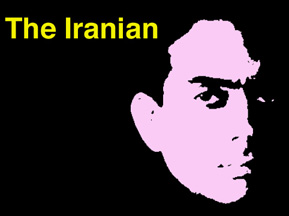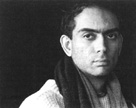
Passion player
The theater of Reza Abdoh
April 10, 2000
The Iranian
 Excerpts from Reza
Abdoh, edited by Daniel Mufson (1999, The Johns Hopkins University
Press). Abdoh was born in Iran, raised in England, and lived and work in
New York and Los Angeles. He was the recipient of a CalArts/Alpert Theater
award in 1995 and a posthumous "Bassie," the Choreographer and
Creator Award for Sustained Achievement. Several of his plays toured extensively
in Europe. Aside from directing his own plays, Abdoh worked in other genres
and media, ranging from a staging of Verdi's Simon Boccanegra to
the making of a feature-lenth film, The Blind Owl. Scenes
from Abdoh plays here
Excerpts from Reza
Abdoh, edited by Daniel Mufson (1999, The Johns Hopkins University
Press). Abdoh was born in Iran, raised in England, and lived and work in
New York and Los Angeles. He was the recipient of a CalArts/Alpert Theater
award in 1995 and a posthumous "Bassie," the Choreographer and
Creator Award for Sustained Achievement. Several of his plays toured extensively
in Europe. Aside from directing his own plays, Abdoh worked in other genres
and media, ranging from a staging of Verdi's Simon Boccanegra to
the making of a feature-lenth film, The Blind Owl. Scenes
from Abdoh plays here
From Daniel Mufson's introduction:
By the time he died of AIDS in the spring of 1995 at the age of 32,
Reza Abdoh had written, assembled, and directed well over a dozen works
for the stage, creating a great stir in that small community of artists,
academics, and critics who concern thmselves with alternative theater.
 Born in Iran, Abdoh spent most of his youth in London
or Los Angeles, and his works, though international in scope, felt distinctly
American, drenched as they were in influences from American popular culture...
Born in Iran, Abdoh spent most of his youth in London
or Los Angeles, and his works, though international in scope, felt distinctly
American, drenched as they were in influences from American popular culture...
Abdoh's works, American in their brashness, iconoclasm, and endless
playfulness, were nonetheless atypical of American theater, above all in
their vehement rejection of sentimentality, happy endings, and a world
in which moral ambiguity is swept aside for the clearly defined realms
of Good and Evil, Victim and Victimizer.
Abdoh knew he was infected with HIV well before he was 25 years old,
and that awareness fueled his work an urgency to which smallness of thought
and gesture was anathema.
From essay by Elinor Fuchs:
After a performance of Tight Right White, the third of Reza Abdoh's
four pieces produced in New York, I had a brief conversation with Reza
and his producer, Diane White, who were standing at the entrance to the
playing space in the cavernous industrial loft. "That last scene was
absolutely out of King Lear," I commented. "Well, yes,"
said Reza to my surprise, "that's what it was supposed to be."
Subsequently I learned that in Los Angeles, at the age of 21, Reaa had
directed his own adaptation of King Lear, a four-hour production performed
in a small Hollywood performance space above a store that seated, according
to White's memory, about forty spectators a night. The night White saw
it, Reza himself stood in for a missing actor and played Edgar.
In the course of following Reza's work in New York, (I did not see the
earlier work created in Los Angeles performed live, though I have seen
some of it on videotape) I came to think that Lear, in its relentless
probing of the extremes of cruelty, psychological disintegration, and physical
vulnerability, was a constant template for his imagination.
More specifically, Reza created "heath scenes." The "heath"
in Abdoh, however, was not a scene of howling winds and raging storm. Rather,
these scenes were uncharacteristically still and silent. They took place,
perhaps in the silent eye of the storm. As in Lear, they were always
marked by the direct relation to nature, a setting otherwise almost antithetical
to Abdoh's work.
Most important, these were scenes of metaphysical exposure to the buffets
of existence, where characters were stripped to a common human identity,
the "bare, forked animal" itself.
In these moments, the masks of cruelty and irony would drop, the hellish
boil of human conflict that was Reza's subject would subside, and the stage
figures would be revealed sub specie aeternitatis, suddenly frail.
They were reduced to gasping for breath, as in Tight Right White,
or crawling toward each other over the bone yard of human culture in Quotations
from a Ruined City.
The Law of Remains intertwined the sadism of Jeffrey Dahmer and
the vacant exhibitionalism of Andy Warhol in what may have been Abdoh's
most savage performance.
It was performed in the decrepit Diplomat Hotel, now demolished, on
West 43rd Street [in New York]. There were video scenes of flesh-peeling
autopsies, tormented characters in wire cages, assaultive chorus lines
whisking down to the genitals in repeated deadpan strip dances, and an
"electrocution" of Dahmer accompanied by plates of bones shoved
in the faces of resisting spectators, then shattered on the fleer -- all
played against an ear-splitting musical and verbal cacophony.
The lights went to black, then silence. When they came up, the spectators
were requested to file out of the performance space.
As the back of the hall was a hitherto unnoticed setting: a grove of
dead trees. The entire cast stood in motionless pairs among these trees,
stripped naked, silent and intently returning our gaze. It was a gaze for
gaze. The only sound was the tolling of bells -- a knell, for them? For
us?
Here was a version of the heath. A moment ago these figures were armored
with an entire repertoire of threatening sounds and gestures. Now, but
for their boots -- they still have boots -- they have taken inadequate
refuge in an unsheltering nature, wordless, and stripped to essential skin.
The scene on the heath marks the central turning point in the action
of King Lear. After the heath, Lear is in flight to Dover; Gloucester's
eyes are put out, and he too struggles towards Dover; Edgar begins his
slow return from Bedlam; Cordelia's forces start to turn the tide.
But for Abdoh, it was as if the play was over once he had reached the
essential revelation: compassion was owed to all "poor naked wretches"
whose "houseless heads and unfed sides" endure the storm.
After the dead forces of The Law of Remains, the performance continued
for one more scene in the ruined upper ballroom of the Diplomat Hotel.
But this coda took place in a kind of diabolic "heaven," the
figures were now shrouded in white and clearly in an enactment that took
place after death. Death was the only scene that could follow Abdoh's heaths.
Tight Right White was Abdoh's scream of protest against racism
and homophobia in historical and present day America. Played, danced, sung,
mimed, and masked with frantic energy among ten stage areas, and interspersed
with clips and reenacted scenes from the film Mandingo, the elements
of the piece were connected through the recurring figures of a young black
(ironically played by a white man in blackface) and a loud, vulgar turn-of-the-century
Jewish vaudeville figure, Moishe Pipik.
Both search for a "real" identity amid the forces that would
make the search impossible: the slave plantation, the KKK, Nazis old and
neo-, withering racial humor. Meanwhile Little Eliza crosses the ice; a
Jew sings a love song in Auschwitz.
It was the final scene that made a direct illusion to the the heath
scene in Lear. The spectators who had followed the actors from stage to
stage, returned to their positions on the floor, facing the ramp that connected
two large, square stages to right and left...
As in the heath scene of King Lear, these matching scenes in
Tight Right White depended on the audience's understanding of the
subjection of the figures to "pitiless" nature. The figures on
the left might not survive: the figures on the right doubled nature's indifference:
they couldn't care less...
"I have been obsessed with doing Lear and have even dreamed about
it," Abdoh told a Los Angeles Times interviewer in January 1985. "The
structure of the play is one of the most magnificent achievements man has
ever done. It's right there with Dante's Inferno and Wagner's Parsifal."
The comparisons suggest that Reza thought of King Lear as a kind
of passion play, and ultimately as a play of redemption.
"Everybody thinks of [Lear] in terms of darkness and dreariness,"
he told the interviewer, apparently aware that his regenerative view of
the play had fallen out of critical favor," but I see the flight of
Lear's and Cordilia's souls as ... uplifting and purified."
The Passion play, making plays of suffering and redemption, was what
Reza's New York work was increasingly about. His first production in New
York, Father Was a Peculiar Man, a loose adaptation of The Brothers
Karamazov, staged in the streets of the wholesale meat district of
Manhattan, became directly that in the near-final scene.
A green Christ was crucified just below a shop sign implacably announcing
the slaughter of the innocents, "Fresh Killed Baby Spring Lamb."
An echo of this moment appeared at the end of [Abdoh's] Quotations
from a Ruined City, when enormous cutouts of butchered beef, lowered
from the ceiling on meat hooks, provided a backdrop to the final moments
of dying lovers crawling toward each other across the stage.
Reza Abdoh's work was in the broadest sense permanently located on the
heath: it was situated on the ground where there is no protection from
the storm, life as storm. Around the wretches gathered there he proceeded
to create a theater of fierce protectiveness, with an impulse to value
every human soul, down to the most vile.
He unrolled a dazzling horror show but even the evil actors on the universal
scene were victims of illusion and and quivering with fear. Everyone was
a side of beef and a lamb of God in his work. He never tried to solve that
"problem."
One of the appeals of King Lear may have been its immense consciousness
of human contradiction. It is sharply confronted in the heath scene, as
Lear rips off his garments to join Edgar's "unaccomodated man."
Abdoh's sense of the range of human experience went to places our theater
cannot for the most part even imagine. Robert Wilson has always said that
King Lear was better in the mind's eye than on the stage, which
could only reduce its size, but Reza's theater uttered screams of rage,
compassion, and truth of Lear-like dimensions. His was truly theater
at the limit. Scenes from Abdoh plays here


![]()